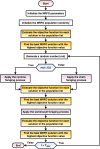Classification of breast cancer using a manta-ray foraging optimized transfer learning framework
- PMID: 36092017
- PMCID: PMC9454783
- DOI: 10.7717/peerj-cs.1054
Classification of breast cancer using a manta-ray foraging optimized transfer learning framework
Abstract
Due to its high prevalence and wide dissemination, breast cancer is a particularly dangerous disease. Breast cancer survival chances can be improved by early detection and diagnosis. For medical image analyzers, diagnosing is tough, time-consuming, routine, and repetitive. Medical image analysis could be a useful method for detecting such a disease. Recently, artificial intelligence technology has been utilized to help radiologists identify breast cancer more rapidly and reliably. Convolutional neural networks, among other technologies, are promising medical image recognition and classification tools. This study proposes a framework for automatic and reliable breast cancer classification based on histological and ultrasound data. The system is built on CNN and employs transfer learning technology and metaheuristic optimization. The Manta Ray Foraging Optimization (MRFO) approach is deployed to improve the framework's adaptability. Using the Breast Cancer Dataset (two classes) and the Breast Ultrasound Dataset (three-classes), eight modern pre-trained CNN architectures are examined to apply the transfer learning technique. The framework uses MRFO to improve the performance of CNN architectures by optimizing their hyperparameters. Extensive experiments have recorded performance parameters, including accuracy, AUC, precision, F1-score, sensitivity, dice, recall, IoU, and cosine similarity. The proposed framework scored 97.73% on histopathological data and 99.01% on ultrasound data in terms of accuracy. The experimental results show that the proposed framework is superior to other state-of-the-art approaches in the literature review.
Keywords: Breast cancer; Convolutional neural network (CNN); Deep learning (DL); Manta-Ray foraging algorithm (MRFO); Metaheuristic optimization.
©2022 N Baghdadi et al.
Conflict of interest statement
The authors declare there are no competing interests.
Figures








References
-
- Abualigah L, Elaziz MA, Khasawneh AM, Alshinwan M, Ibrahim RA, Al-qaness MA, Mirjalili S, Sumari P, Gandomi AH. Meta-heuristic optimization algorithms for solving real-world mechanical engineering design problems: a comprehensive survey, applications, comparative analysis, and results. Neural Computing and Applications. 2022;34:4081–4110. doi: 10.1007/s00521-021-06747-4. - DOI
-
- Agarwal N, Sondhi A, Chopra K, Singh G. Transfer learning: survey and classification. In: Tiwari S, Trivedi M, Mishra K, Misra A, Kumar K, Suryani E, editors. Smart innovations in communication and computational sciences. vol. 1168. Springer; Singapore: 2021. (Advances in intelligent systems and computing). - DOI
-
- Alshinwan M, Abualigah L, Shehab M, Elaziz MA, Khasawneh AM, Alabool H, Hamad HA. Dragonfly algorithm: a comprehensive survey of its results, variants, and applications. Multimedia Tools and Applications. 2021;80(10):14979–15016. doi: 10.1007/s11042-020-10255-3. - DOI
LinkOut - more resources
Full Text Sources
